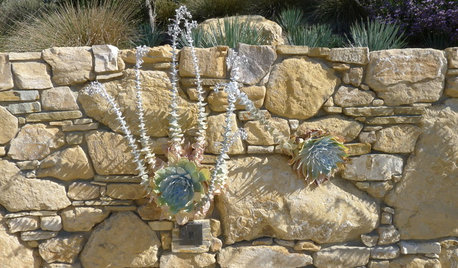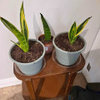Is my snake plant doomed?
tommo4
6 years ago
Featured Answer
Sort by:Oldest
Comments (9)
tommo4
6 years agoRelated Discussions
HELP! Are my strawberry plants doomed??
Comments (12)I think you have plenty of time to get the bed ready if you are willing to do some work and also carefully monitor after planting. If I was in your situation I would turn the soil and sod over with a shovel. I'd dig deeply trying to make sure most of the sod ends up buried. One way to do this is to dig a trench the width of the bed and place the soil to the side, making the trench at least 18 inches deep. Then you can turn the soil next to the trench over into the trench, making sure the sod on top ends up upside down in the bottom of the trench, and the soil from the below the sod ends up on top. This will, in effect, move the trench about a foot or so farther into the garden. It has to be done shovelful by shovelful and requires some work, but if you slice off managable sized vertical slices of sod and soil it isn't backbreaking. You can use the shovel and your weight to cut a slice of sod and soil off the edge of the trench, then flip it into the trench. You keep going this way, turning the soil into the trench, burying the sod, and moving the trench along through the bed, leaving behind freshly turned soil. Finally, you can take the original soil removed from the trench and use it to fill the trench, which will have mirated ot the far end of the bed. This is also an opportunity to incorporate organic material into the soil, which impproves any soil. I would normally recommend that you add 6 inches of organic matter such as compost on top of the sod before you turn the bed over, but in this case, since strawberryes are hard to remove weeds from, your first priority should be to make sure that all the sod gets buried. The presence of the compost (or manure, or leaf mold, or peat moss, etc.) can make it a little harder to see the sod, but if you think you are up to it, the organic matter will really help. Once the bed is turned over and you have picked out any bits of green grass you see sticking through, place a mulch over the entire surface. I like organic mulches like leaves, grass clippings, etc., but many people use black plastic or landscape cloth. In any case, you want a thick mulch that will prevent any weeds or grass from growing through. wait a few weeks to allow the grass below to die, and plant your strawberries. Monitor very carefully all summer to make sure no grass is permitted go grow between the strawberries. I would not recommend using a rototiller for this. A rototiller will mix the grass with the soil, leaving a lot of the grass on the soil surface where it will try to regrow. Also, I don't like tillers in general because they don't get deep enough an often leave a hardened layer just below the tilled soils, caused by the tines hitting the soil below. If you have the ability, nothing can beat tilling with a shovel (although it is a lot slower)....See MoreHELP!!! My snake plant is dying
Comments (26)MRJoss, Mine is doing something similar. I brought it home from Calloways about a month ago and left it in a similar light setting to what they had (low) to acclamate to the house. It started as a small brown spot that expanded quickly. The same thing is starting to happen to multiple leaves. I haven't overwatered it or fertilized it. It is very ugly now and too many leaves are effected to remove them and have a substantial plant left. I'm going to try to return it. This bottom of this article refers to the problem: http://www.ourhouseplants.com/plants/sansevieria . All of the other plants purchased at the time are doing great - multiple succulents and cactus, a dracaenas, a pothos, and several ferns....See MoreIam a new to container gardens. I repotted my snake plant and Dracanea
Comments (3)You may be more successful at getting an answer on the House Plants forum. https://www.gardenweb.com/discussions/houseplt...See MoreBroke my snake plant while repotting, need help!
Comments (1)Give it a try! Our daughter used to cut pieces of the “leaf” and stick it in soil… kept it watered and it grew roots....See Morerobin98
6 years agoStush2049 Pitts. PA, zone 6
6 years agotommo4
6 years agoKaren S. (7b, NYC)
6 years agoEmily Valin
3 years agotommo4
3 years agoStush2049 Pitts. PA, zone 6
3 years agolast modified: 3 years ago
Related Stories

HOUSEPLANTS10 Top Plants to Grow Indoors
Brighten a room and clean the air with a houseplant that cascades artfully, stretches toward the ceiling or looks great on a wall
Full Story
CONTAINER GARDENSFreshen Up the Bath With Lush and Healthy Plants
Learn how to choose and care for plants that will do well in your space
Full Story
GARDENING GUIDESGreat Design Plant: Creeping Juniper Holds Its Ground
Add texture and evergreen interest to a layered garden with this low-maintenance, good-looking ground cover
Full Story
LIFEOh Yeah, There’s a Snake in the House
A Houzz contributor lives through her worst nightmare and comes out the other side with lessons learned and new footwear
Full Story
GARDENING GUIDESPlant Fritillary Bulbs for Something a Little Different
These unusual plants with unexpected colors and lance-like foliage add interest to lightly shaded garden beds
Full Story
PLANTING IDEASPlanting Ideas: Life in the Crevices
Discover the beautiful planting opportunities hidden in rock walls, paver spaces and other garden gaps
Full Story
HOLIDAYSHisssss: Get Wrapped Up in the Year of the Snake
Throw your home some welcome curves with sinuous forms and reptilian patterns on all kinds of home decor
Full Story
GARDENING GUIDESWe Bust 4 More Native Plant Myths
Have you been taken in by these fallacies about gardening with native plants?
Full Story
PLANTING IDEAS7 Stunning Plant Combinations for Low-Water Gardens
Find inspiration in these beautiful drought-tolerant companion plantings
Full Story
HOUSEPLANTS8 Essentials for Healthy Indoor Plants
Houseplants add so much to our homes — and can thrive when grown in the right conditions. Keep these tips in mind
Full StorySponsored
Your Custom Bath Designers & Remodelers in Columbus I 10X Best Houzz









Oyster